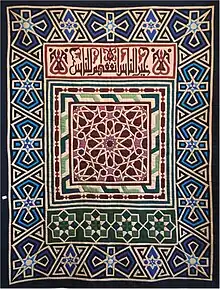| Established | 1991 |
|---|---|
| Location | Hogewoerd 164, Leiden |
| Coordinates | 52°9′19.7″N 4°30′6.34″E / 52.155472°N 4.5017611°E |
| Director | G.M. Vogelsang-Eastwood (2010) |
| Website | www |

The Textile Research Centre (TRC), Leiden, Netherlands, is an independent research institute working in the field of textiles and dress.[1] It is housed at Hogewoerd 164 in Leiden and includes exhibition space, storage rooms, a lecture room and other working areas. The current director of the TRC (as of 2020) is Gillian Vogelsang-Eastwood, a textile and dress historian.
Aims
The TRC has the stated aim of teaching textile crafts and encouraging research into anthropological and archaeological textiles and clothing in the widest sense of the word. In particular, the TRC specialises in dress - what people wear in order to express their identity - and pre-industrial textile technology.[2]
History
The TRC was founded in 1991 as a Stichting (foundation; non-profit organisation). Since then it has been involved in many aspects of the academic study of textiles and dress, especially those from the Near East.
In 1997 the TRC started building up a textile and dress collection. By late-2022 the collection had grown to over 40,000 textiles, garments and accessories from all over the world. It also has a large collection of Dutch regional dress. Many of the garments were obtained during fieldwork by TRC staff and students, whilst others were purchased or given as donations.
Until August 2009 the TRC was housed in the National Museum of Ethnology, Leiden, but since then it has moved to new premises in the centre of Leiden (Hogewoerd 164). It now organises a series of exhibitions, lectures, workshops and training courses for students and others who are interested.
Middle Eastern dress remains a focal point of the TRC. The veils in the TRC collection, for instance, were used for a major exhibition at the National Museum of Ethnology, Leiden (1996), and for various publications, including Covering the Moon: An Introduction to Middle Eastern Face Veils.[3]
Publications
Exhibitions
- De Kleren van de farao: National Museum of Antiquities, Leiden (1994; travelled to Denmark and Germany). An exhibition about textiles and clothing in Ancient Egypt.[4]
- Sluiers ontsluierd (For Modesty’s Sake?): National Museum of Ethnology, Leiden (1996–1997). An exhibition about the history and use of veils and face veiling in the Near East.[5]
- Tutankhamun’s Wardrobe: Textile Museum of Borås, Sweden (1999). An exhibition with replicas of the garments found in the tomb of the ancient Egyptian pharaoh, Tutankhamun. This exhibition travelled to Britain, Denmark, Egypt, the Netherlands, Poland and the United States, and is now permanently based at the Textile Museum, Boras, Sweden.[6]
- Hajj: National Museum of Ethnology, Leiden (2004–2005). An exhibition about the Hajj and the clothing (ihram) worn by Muslim pilgrims to Mecca.
- Flowing Robes: Clothing and Jewellery from Saudi Arabia: National Museum of Ethnology, Leiden (2006–2007).[7]
- Dutch Lace Caps (Stadhuis Leiden, 2007–2008)[7][8]
- The Indian sari (National Museum of Ethnology, Leiden, 2010)[9]
- Embroidery from the Arab World (TRC Gallery, 2010)[10][11]
- Well Dressed Afghanistan (TRC Gallery, 2010–2011)[12]
References
- ↑ "Textile Research Centre, Leiden". Retrieved 2010-11-18.
- ↑ "General information". www.trc-leiden.nl. Retrieved 8 September 2018.
- ↑ Vogelsang-Eastwood, Gillian; Vogelsang, W. J. (2008). Covering the Moon: An Introduction to Middle Eastern Face Veils. Peeters. ISBN 9789042919907.
- ↑ Vogelsang-Eastwood, Gillian (1994). De Kleren Van de Farao. De Bataafsche Leeuw. ISBN 978-9067073608. (exhibition catalogue, National Museum of Antiquities, Leiden, Netherlands.
- ↑ Vogelsang-Eastwood, G. M. (2009). For Modesty's Sake?. Barjesteh, Meeuwes & Co. ISBN 978-9056130176. (exhibition catalogue; National Museum of Ethnology, Leiden, Netherlands; Dutch edition: Sluiers Ontsluierd)
- ↑ Vogelsang-Eastwood, G. M. (1999). Tutankhamun's Wardrobe: Garments from the Tomb of Tutankhamun. Barjesteh van Waalwijk van Doorn & Co. ISBN 90-5613-042-0.
- 1 2 "The diversity of the TRC collection". www.trc-leiden.nl. Retrieved 8 September 2018.
- ↑ van Velde-Lagendijk, Riet; Vogelsang-Eastwood, Gillian; Rooijakkers, Tineke (2007). Kanten mutsen uit Nederland/Dutch lace caps. Leiden : Textile Research Centre. ISBN 9789056130954.
- ↑ "Exhibition of Indian Saris". www.trc-leiden.nl. Retrieved 8 September 2018.
- ↑ "Embroidery from the Arab World". www.trc-leiden.nl. Retrieved 8 September 2018.
- ↑ Vogelsang-Eastwood, Gillian (2010). Embroidery from the Arab world. Primavera Press. ISBN 978-9059970892.
- ↑ "Exhibition: Well-dressed Afghanistan". www.trc-leiden.nl. Retrieved 8 September 2018.
External links
Further reading
- Eicher, J. B.; Roach-Higgins, M. E. (1992). "Definition and classification of dress: Implications for analyses of gender roles". In Barnes, R.; Eicher, J. B. (eds.). Dress and Gender. Making and Meaning in Cultural Contexts. New York: St. Martin’s Press. pp. 9–28. ISBN 9780854967209.